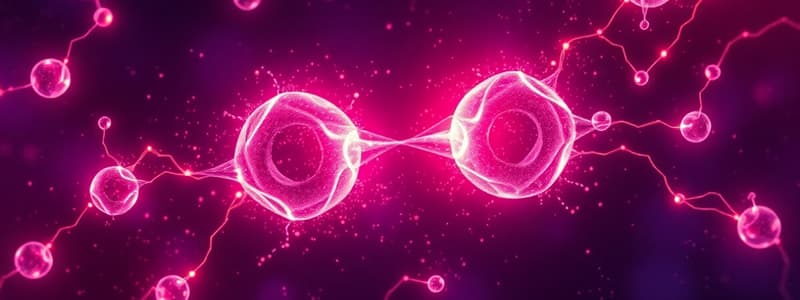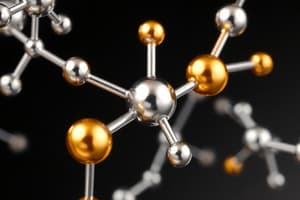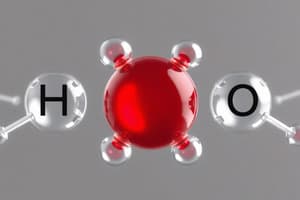Podcast
Questions and Answers
What is a chemical bond?
What is a chemical bond?
- The force of attraction between different chemical elements
- The energy required to break a compound apart
- The distance between atomic nuclei in a molecule
- The force of attraction that holds atoms or ions together (correct)
What characterizes an ionic bond?
What characterizes an ionic bond?
- Formation of covalent bonds between non-metals
- Weak attraction between neutral atoms
- Sharing of electrons between atoms
- Transfer of electrons resulting in charged ions (correct)
Which of the following describes ionic compounds?
Which of the following describes ionic compounds?
- They are formed by sharing of electrons
- They contain both cations and anions (correct)
- They are always gases at room temperature
- They consist only of anions
In the formation of sodium chloride (NaCl), what happens to the sodium atom?
In the formation of sodium chloride (NaCl), what happens to the sodium atom?
How are electrons represented in atomic orbit structure diagrams?
How are electrons represented in atomic orbit structure diagrams?
What happens to the chlorine atom during the formation of NaCl?
What happens to the chlorine atom during the formation of NaCl?
What type of attraction forms between cations and anions in ionic compounds?
What type of attraction forms between cations and anions in ionic compounds?
What is depicted in atomic orbit structure diagrams?
What is depicted in atomic orbit structure diagrams?
What happens when sodium loses an electron?
What happens when sodium loses an electron?
What is the ideal electronic configuration described by the octet rule?
What is the ideal electronic configuration described by the octet rule?
What type of bond is formed through the transfer of electrons?
What type of bond is formed through the transfer of electrons?
What charge does a chloride ion carry after gaining an electron?
What charge does a chloride ion carry after gaining an electron?
What occurs between oppositely charged ions in ionic compounds?
What occurs between oppositely charged ions in ionic compounds?
What is the electronic configuration of a sodium ion (Na+)?
What is the electronic configuration of a sodium ion (Na+)?
Which statement about calcium and oxygen during the formation of calcium oxide (CaO) is accurate?
Which statement about calcium and oxygen during the formation of calcium oxide (CaO) is accurate?
What is the charge of a magnesium ion (Mg2+) after losing two electrons?
What is the charge of a magnesium ion (Mg2+) after losing two electrons?
Which compound is formed when magnesium loses two electrons and two chlorine atoms gain those electrons?
Which compound is formed when magnesium loses two electrons and two chlorine atoms gain those electrons?
What is the net charge of two chloride ions formed from two chlorine atoms?
What is the net charge of two chloride ions formed from two chlorine atoms?
When atom X tends to lose three electrons, what type of ion does it form?
When atom X tends to lose three electrons, what type of ion does it form?
Which ionic compound is represented by the formula X2SO4?
Which ionic compound is represented by the formula X2SO4?
What happens in the atomic orbit structure of XY2 similar to magnesium chloride?
What happens in the atomic orbit structure of XY2 similar to magnesium chloride?
What charge does an oxide ion (O2-) have after gaining two electrons?
What charge does an oxide ion (O2-) have after gaining two electrons?
Flashcards
Chemical Bond
Chemical Bond
The force that holds atoms or ions together in a chemical compound.
Ionic Bond
Ionic Bond
A type of chemical bond where electrons are transferred from one atom to another.
Ionic Compounds
Ionic Compounds
Compounds formed by the transfer of electrons, resulting in oppositely charged ions.
Ionic Bond Formation
Ionic Bond Formation
Signup and view all the flashcards
Ions
Ions
Signup and view all the flashcards
Atomic Orbit Structure Diagrams
Atomic Orbit Structure Diagrams
Signup and view all the flashcards
Cation
Cation
Signup and view all the flashcards
Anion
Anion
Signup and view all the flashcards
Octet Rule
Octet Rule
Signup and view all the flashcards
Why do atoms form bonds?
Why do atoms form bonds?
Signup and view all the flashcards
What happens in ionic bonding?
What happens in ionic bonding?
Signup and view all the flashcards
What are ionic compounds?
What are ionic compounds?
Signup and view all the flashcards
How does sodium achieve stability?
How does sodium achieve stability?
Signup and view all the flashcards
How does chlorine achieve stability?
How does chlorine achieve stability?
Signup and view all the flashcards
What is an ionic bond?
What is an ionic bond?
Signup and view all the flashcards
What is sodium chloride (NaCl)?
What is sodium chloride (NaCl)?
Signup and view all the flashcards
How does calcium achieve stability?
How does calcium achieve stability?
Signup and view all the flashcards
How does oxygen achieve stability?
How does oxygen achieve stability?
Signup and view all the flashcards
What is the bond in calcium oxide (CaO)?
What is the bond in calcium oxide (CaO)?
Signup and view all the flashcards
How does magnesium achieve stability?
How does magnesium achieve stability?
Signup and view all the flashcards
What is the bond in magnesium chloride (MgCl2)?
What is the bond in magnesium chloride (MgCl2)?
Signup and view all the flashcards
What happens to an atom with three more electrons than a noble gas?
What happens to an atom with three more electrons than a noble gas?
Signup and view all the flashcards
What is the rule for writing the formula of an ionic compound?
What is the rule for writing the formula of an ionic compound?
Signup and view all the flashcards
Study Notes
Chemical Bonding
- A chemical bond is the attractive force holding atoms or ions together, creating chemical species.
Ionic Bonding
- Ionic bonds form when one element transfers electrons to another.
- Electron transfer creates oppositely charged ions.
- Strong electrostatic attraction between opposite ions creates a stable ionic compound.
Ionic Compounds
- Ionic compounds are composed of cations (positive ions) and anions (negative ions).
- Electrostatic attraction holds the ions together.
Formation of Ionic Compounds: Sodium Chloride (NaCl)
- Sodium chloride demonstrates ionic bond formation.
- Sodium (Na) has one outer electron; chlorine (Cl) has seven.
- Sodium loses its outer electron, becoming Na+; chlorine gains it, becoming Cl-.
- The opposite charges attract, forming the ionic bond in NaCl.
Atomic Orbit Structure Diagrams
- Diagrams illustrate atomic electron arrangements and changes during bonding.
- Diagrams show the atom's nucleus, electron shells, and electrons.
- Electron symbols (dots, crosses, etc.) represent individual electrons.
- The number of shells matches the atom's electronic configuration.
- Determining electronic configuration guides diagram creation.
- Sodium and chlorine's diagrams show electron transfer.
Stability and Octet Rule
- Atoms achieve stability with a full outer electron shell (octet rule).
- Eight electrons fill the outer shell; this is a stable arrangement.
- Atoms gain or lose electrons to achieve the electronic configuration of a nearby noble gas.
- Sodium achieves neon's configuration (2,8); chlorine achieves argon's (2,8,8).
Key Points for Understanding Ionic Bonding
- Ionic bonding involves electron transfer between atoms.
- Electron transfer forms ions with opposite charges.
- Electrostatic forces hold ionic compounds together.
- Atomic orbit diagrams visualize ionic compound structure.
- Atoms seek stability by attaining a full outermost shell.
Further Examples
- Magnesium chloride (MgCl2) and calcium oxide (CaO) exemplify ionic compound formation.
- These compound formations follow similar principles as sodium chloride.
- Analyzing electron configurations predicts electron transfer and resulting ion composition.
Formation of Sodium Chloride (NaCl)
- Sodium's outermost electron is transferred to chlorine.
- Sodium (1 outer electron) loses it, becoming Na+ (2,8).
- Chlorine (7 outer electrons) gains it, becoming Cl- (2,8,8).
- Opposite charges in Na+ and Cl- attract, forming an ionic bond.
Formation of Calcium Oxide (CaO)
- Calcium (2 outer electrons) loses them, becoming Ca2+ (2,8,8).
- Oxygen (6 outer electrons) gains two electrons, becoming O2- (2,8).
- Oppositely charged Ca2+ and O2- attract, forming an ionic bond.
Formation of Magnesium Chloride (MgCl2)
- Magnesium (2 outer electrons) loses them, becoming Mg2+ (2,8).
- Chlorine (7 outer electrons) gains one electron to become Cl- (2,8,8).
- Mg2+ attracts two Cl- ions, forming MgCl2.
Formation of Chloride Ions
- Chlorine atoms gain one electron each to become chloride ions (Cl-).
- Chloride ions have 17 protons and 18 electrons.
Magnesium Chloride Formation
- Magnesium loses two electrons to form Mg2+.
- Mg2+ has the electronic configuration (2,8).
- Two chlorine atoms each gain one electron, forming two Cl-.
- The attraction between Mg2+ and two Cl- ions creates the ionic bond.
Formation of Ionic Compounds
- Ionic compounds form through electron transfer.
- Electron transfer results in the formation of oppositely charged ions.
- MgCl2 is a common example of an ionic compound.
Atom X and its Ion
- Atom X has three more electrons than a noble gas configuration and tends to lose 3 electrons to form X³⁺.
Formulas of Compounds Containing X³⁺
- X₂SO₄ (X³⁺ and sulfate)
- X(NO₃)₃ (X³⁺ and nitrate)
- X₃(PO₄) (X³⁺ and phosphate)
- X₂(CO₃)₃ (X³⁺ and carbonate)
- X(OH)₃ (X³⁺ and hydroxide)
Compound XY₂
- X transfers one electron to each Y, forming XY₂ (an ionic compound).
Atomic Orbit Structure of XY₂
- XY₂'s atomic orbit structure mirrors MgCl₂'s with X replacing Mg and Y replacing Cl.
Studying That Suits You
Use AI to generate personalized quizzes and flashcards to suit your learning preferences.




